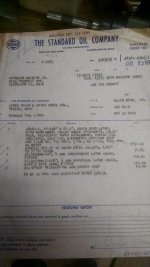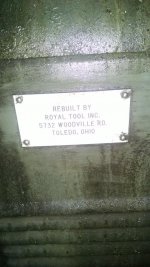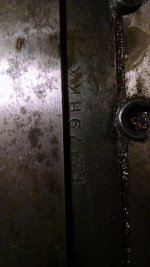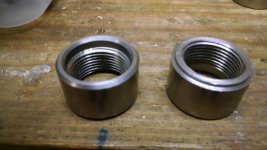Hi! Im Fohman and this is my thread!
I have a 16" Southbend and I use it hard every day. I think its a 1952. Not sure. But I have a lot of info that suggests it is, perhaps a Southbend history fellow can help identify it. Here is the receiving order for it from Standard Oil back in 1953.

The problem is the description doesn't match the machine. The machine is not 14 1/2" its a 16". And its not 8'-0 long its more like 6 1/2 feet long.

But the Plant Record number matches at 8388 on the receiving documents and on the back of the lathe. So I am thinking its a 1952 16" Southbend.

Here is what I think the serial number is from the machine if you can help with identification that would be cool.

I bought this machine in 1984 for $2,500 and I was told it was rebuilt in 1982 by this outfit.

I don't have documentation supporting that outside their nameplate on the side of the machine.
I used this machine for about 4 months back in 1984, then it sat in a barn for 30 years. I just pulled it out a couple years ago, and now I run it hard every day!
Looking at the original PO it cost $2,431 brand new! So at $2,500 when I bought it I think I overpaid! I got everything listed on the PO when I bought it except for the CL-2400 telescoping center rest for $23.00. So if anyone out there has one of these I would gladly pay 3 times original price for it plus shipping!
While the history of this old Southbend lathe is interesting, that's not what my thread is about, you'll see that as I add to.."my" thread. I use this machine every day! I would like to show you how I use it. We think we run it as effectively as possible. We think we are creative and innovative in what we do! And I would love to hear your input on what we do with this old machine, and how we could do it better or more efficiently!
We run this old Southbend hard! We make thousands and thousands of parts on it. Its all we got. What I really love about this old Southbend is it is just so so so simple! I can train a person to run this machine and make perfect parts in 20 minutes! We break the machining operations down into simple tasks that are quick and efficient, anybody can run this thing!
Most of the information I'll post on operation of this machine will be in video format. Take a minute and check it out! Definatly interested in your comments on what we do with this old Southbend!
Everything we do has been done hundreds of times before but sometimes something old all of a sudden becomes something new!
I have a 16" Southbend and I use it hard every day. I think its a 1952. Not sure. But I have a lot of info that suggests it is, perhaps a Southbend history fellow can help identify it. Here is the receiving order for it from Standard Oil back in 1953.

The problem is the description doesn't match the machine. The machine is not 14 1/2" its a 16". And its not 8'-0 long its more like 6 1/2 feet long.

But the Plant Record number matches at 8388 on the receiving documents and on the back of the lathe. So I am thinking its a 1952 16" Southbend.

Here is what I think the serial number is from the machine if you can help with identification that would be cool.

I bought this machine in 1984 for $2,500 and I was told it was rebuilt in 1982 by this outfit.

I don't have documentation supporting that outside their nameplate on the side of the machine.
I used this machine for about 4 months back in 1984, then it sat in a barn for 30 years. I just pulled it out a couple years ago, and now I run it hard every day!
Looking at the original PO it cost $2,431 brand new! So at $2,500 when I bought it I think I overpaid! I got everything listed on the PO when I bought it except for the CL-2400 telescoping center rest for $23.00. So if anyone out there has one of these I would gladly pay 3 times original price for it plus shipping!
While the history of this old Southbend lathe is interesting, that's not what my thread is about, you'll see that as I add to.."my" thread. I use this machine every day! I would like to show you how I use it. We think we run it as effectively as possible. We think we are creative and innovative in what we do! And I would love to hear your input on what we do with this old machine, and how we could do it better or more efficiently!
We run this old Southbend hard! We make thousands and thousands of parts on it. Its all we got. What I really love about this old Southbend is it is just so so so simple! I can train a person to run this machine and make perfect parts in 20 minutes! We break the machining operations down into simple tasks that are quick and efficient, anybody can run this thing!
Most of the information I'll post on operation of this machine will be in video format. Take a minute and check it out! Definatly interested in your comments on what we do with this old Southbend!
Everything we do has been done hundreds of times before but sometimes something old all of a sudden becomes something new!









